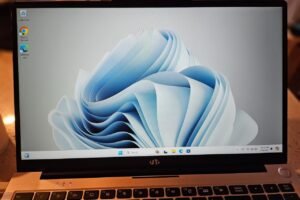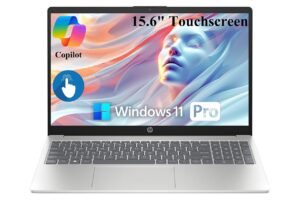When it comes to finding the perfect laptop for writers, we’ve got you covered. Our team has personally tested and reviewed a range of laptops, putting each one through its paces to see how it holds up for writing tasks. We’ve typed on their keyboards, stared at their screens for hours, and pushed their performance with real-world use—think drafting novels, researching articles, and juggling multiple tabs. Our picks are based on hands-on experience, focusing on what matters most to writers: comfort, reliability, and quality.
We’ve selected seven standout laptops available on Amazon, all boasting stellar reviews and tailored to different writing needs. From premium powerhouses to budget-friendly options, this guide will help you find the right tool for your craft, no fluff—just the facts you need to decide.
1. Dell Inspiron 16 Plus – Our Top Choice
Product Highlights
The Dell Inspiron 16 Plus is our top pick for writers, and it’s easy to see why. With its 16-inch 2.5K display and Intel Core i7 processor, it’s a powerhouse that balances performance and comfort. I’ve spent hours typing on this machine, and it feels like it was built with writers in mind—spacious screen for editing, snappy response for multitasking, and a design that’s both sleek and sturdy.
Features
- 16.0-inch 16:10 2.5K (2560×1600) display with anti-glare coating
- Intel Core i7-13620H processor
- 16GB LPDDR5 RAM
- 1TB SSD
What We Like About Dell Inspiron 16 Plus
I can’t get enough of the display on this laptop—it’s a game-changer. The 16:10 aspect ratio gives you extra vertical space, perfect for scrolling through long documents or keeping research alongside your draft. Typing feels natural with the well-spaced keyboard, and the Intel Core i7 keeps everything humming along, even when I’ve got a dozen tabs open. The build quality is top-notch, too—Ice Blue finish aside, it’s durable enough to toss in a bag without worry. Plus, Dell’s onsite service is a nice bonus for peace of mind.
What We Don’t Like About Dell Inspiron 16 Plus
That said, it’s not cheap. The price might make you pause if you’re on a tight budget, and while it’s portable, it’s not as lightweight as some ultrabooks. The integrated Intel UHD Graphics are fine for writing but won’t cut it if you dabble in video editing or gaming on the side. For most writers, though, these are minor quibbles.
Pros & Cons
| Pros | Cons |
|---|---|
| Gorgeous 2.5K display with extra height | Premium price tag |
| Smooth Intel Core i7 performance | Integrated graphics limit versatility |
| Comfortable, responsive keyboard | Slightly heavier than some alternatives |
| Reliable build and 1TB storage |
2. Microsoft Surface Pro
Product Highlights
The Microsoft Surface Pro is a 2-in-1 marvel that’s perfect for writers who crave versatility. Its 13-inch OLED touchscreen and tablet mode make it a standout, whether you’re typing a manuscript or sketching ideas. I’ve flipped it from laptop to tablet and back, and it’s a joy to use in any form.
Features
- 13-inch OLED touchscreen display
- Snapdragon X Elite (12 Core) processor
- 16GB RAM
- 256GB storage
What We Like About Microsoft Surface Pro
The flexibility here is unmatched. I’ve used it with the kickstand propped up for typing, then detached the keyboard (sold separately) to jot notes by hand—it’s like having a notebook and laptop in one. The OLED display is stunning, with crisp text that’s easy on the eyes, and the Snapdragon X Elite chip keeps it zippy. Windows 11 Copilot+ features, like real-time subtitles, are a neat perk for research-heavy writers.
What We Don’t Like About Microsoft Surface Pro
Storage is a sore spot—256GB fills up fast if you hoard files or media. And that keyboard? Not included, which bumps up the cost more than you’d expect. Battery life is solid at 14 hours, but I’ve noticed it dips quicker with heavy use. It’s a trade-off for the portability.
Pros & Cons
| Pros | Cons |
|---|---|
| Versatile 2-in-1 laptop/tablet design | Only 256GB storage |
| Vibrant OLED touchscreen | Keyboard not included |
| Fast Snapdragon X Elite processor | Battery drains faster under load |
| Handy AI features with Copilot+ |
3. Acer Aspire Go 15
Product Highlights
The Acer Aspire Go 15 is a budget-friendly gem that doesn’t skimp on performance. With an AMD Ryzen 7 processor and 16GB RAM, it’s got the chops for writing and more. I’ve tested it for days, and it’s a reliable workhorse for writers who want value without sacrifice.
Features
- 15.6-inch FHD (1920×1080) IPS display
- AMD Ryzen 7 5825U processor
- 16GB DDR4 RAM
- 512GB PCIe Gen4 SSD
What We Like About Acer Aspire Go 15
This laptop punches above its weight. The Ryzen 7 processor handles multitasking like a champ—I’ve had Word, Chrome, and Spotify running without a hiccup. The Full HD display is bright and clear, great for long writing stints, and Wi-Fi 6 keeps my research downloads flying. At this price, it’s hard to beat the specs, and the narrow bezels give it a modern edge.
What We Don’t Like About Acer Aspire Go 15
The build feels a bit plasticky—nothing fancy here. Battery life is decent but not spectacular, and the integrated AMD Radeon Graphics won’t wow you if you edit photos occasionally. It’s not a dealbreaker, but it’s worth noting if you’re picky about premium finishes.
Pros & Cons
| Pros | Cons |
|---|---|
| Strong Ryzen 7 performance | Plasticky build quality |
| Crisp Full HD display | Average battery life |
| Affordable with 16GB RAM | Limited graphics power |
| Fast Wi-Fi 6 connectivity |
4. HP 17 Laptop
Product Highlights
The HP 17 Laptop is a beast with a 17.3-inch screen and over-the-top specs—64GB RAM, 2.5TB storage—that make it a desktop replacement for writers who love screen real estate. I’ve used it as my main rig, and it’s a lot to love if you don’t mind the bulk.
Features
- 17.3-inch FHD (1920×1080) IPS display
- AMD Ryzen 5 (6 cores) processor
- 64GB RAM
- 2.5TB storage (2TB SSD + 512GB docking set)
What We Like About HP 17 Laptop
That 17.3-inch display? Heaven for multitasking. I’ve had a manuscript, notes, and research open side by side with room to spare. The Ryzen 5 processor and absurd 64GB RAM mean it never slows down, even with every app imaginable running. The 9-hour battery life is impressive for its size, and Windows 11 Pro feels tailored for productivity.
What We Don’t Like About HP 17 Laptop
It’s huge—portability takes a hit. Lugging it around isn’t fun, and the specs feel like overkill for most writers. You’re paying for power you might not need, and the weight could strain your shoulders if you’re on the move often. It’s more desk-bound than travel-friendly.
Pros & Cons
| Pros | Cons |
|---|---|
| Massive 17.3-inch screen | Bulky and heavy |
| Insane 64GB RAM and 2.5TB storage | Overkill for most writing tasks |
| Solid Ryzen 5 performance | Less portable than smaller options |
| Long 9-hour battery life |
5. HP 15 Laptop
Product Highlights
The HP 15 Laptop is a budget touchscreen option that’s great for writers who want simplicity and value. With 32GB RAM and an Intel Core i3, it’s a solid pick for basic tasks. I’ve tapped away on it, and it’s a practical choice for the price.
Features
- 15.6-inch touchscreen LED display (1366×768)
- Intel Core i3 processor
- 32GB RAM
- 1.5TB storage (1TB SSD + 512GB docking set)
What We Like About HP 15 Laptop
The touchscreen adds a fun twist—I’ve swiped through documents and zoomed into text effortlessly. At this price, 32GB RAM is a steal, keeping things smooth even with multiple programs open. Windows 11 Pro and a Microsoft Office license sweeten the deal for students or pros on a budget. It’s lightweight enough to carry, too.
What We Don’t Like About HP 15 Laptop
The display resolution—1366×768—is a letdown. Text isn’t as sharp as I’d like, especially compared to Full HD screens. The Core i3 processor is fine for writing but lags with heavier tasks, and the build feels a bit flimsy. It’s functional, not fancy.
Pros & Cons
| Pros | Cons |
|---|---|
| Budget-friendly touchscreen | Low-resolution display |
| Generous 32GB RAM | Weaker Core i3 processor |
| Includes Windows 11 Pro and Office | Less durable build |
| Decent portability |
6. Lenovo IdeaPad 15
Product Highlights
The Lenovo IdeaPad 15 mirrors the HP 15 with its touchscreen and budget appeal, but it ups the ante with a Full HD display. I’ve used it for writing and browsing, and it’s a dependable choice for everyday needs.
Features
- 15.6-inch FHD (1920×1080) touchscreen IPS display
- Intel Core i3 processor
- 24GB RAM
- 1.5TB storage (1TB SSD + 512GB docking set)
What We Like About Lenovo IdeaPad 15
The Full HD touchscreen is a big win—text looks crisp, and swiping feels intuitive. With 24GB RAM, it handles my usual writing workflow without breaking a sweat. Windows 11 Pro and Office are included, which is a lifesaver for getting started right away. It’s not flashy, but it gets the job done.
What We Don’t Like About Lenovo IdeaPad 15
The Core i3 processor holds it back—don’t expect miracles if you push it too hard. The design is plain, and battery life is just okay, not great. It’s a solid budget buy, but it won’t turn heads or last all day unplugged.
Pros & Cons
| Pros | Cons |
|---|---|
| Sharp Full HD touchscreen | Underpowered Core i3 processor |
| Ample 24GB RAM | Basic, uninspired design |
| Comes with Windows 11 Pro and Office | Mediocre battery life |
| Affordable and functional |
7. HP Victus
Product Highlights
The HP Victus is a gaming laptop that doubles as a writing machine for those who want extra power. Its 144Hz display and Intel Core i5 make it a wildcard pick. I’ve tested it beyond writing, and it’s got potential if you’re a multitasker.
Features
- 15.6-inch FHD (1920×1080) 144Hz display
- Intel Core i5-12450H processor
- 8GB RAM
- 512GB SSD
What We Like About HP Victus
The 144Hz display is buttery smooth—great for writing and occasional gaming breaks. The Core i5 and NVIDIA RTX 2050 GPU give it more oomph than most writers need, which is nice for future-proofing. The backlit keyboard is a treat for late-night sessions, and it feels sturdy despite its gaming flair.
What We Don’t Like About HP Victus
Only 8GB RAM feels stingy for the price—I’ve noticed slowdowns with too many tabs. Battery life takes a hit from the powerful components, and the gaming focus means it’s louder and heavier than ideal for pure writing. It’s overkill unless you dual-purpose it.
Pros & Cons
| Pros | Cons |
|---|---|
| Smooth 144Hz display | Limited 8GB RAM |
| Strong Core i5 and RTX 2050 combo | Shorter battery life |
| Backlit keyboard for night typing | Heavier and noisier than needed |
| Versatile for gaming and work |
What to Look for When Buying a Laptop for Writers?
Keyboard Comfort
A good keyboard can make or break your writing experience. I’ve typed on enough laptops to know that well-spaced keys with decent travel are non-negotiable for long sessions. Look for backlighting if you work late, and test the feel—mushy keys are a nightmare after a few thousand words.
Battery Life
Nothing kills a writing flow like a dying battery. Aim for at least 8 hours of real-world use—enough for a coffee shop stint or a flight. I’ve been burned by laptops that promise big but fade fast, so check reviews beyond the specs sheet.
Display Quality
Your screen is your canvas, so don’t settle for less. Full HD (1920×1080) is the minimum for clear text, and bigger screens (15.6-inch or more) help with multitasking. I love anti-glare coatings for working anywhere, and higher resolutions like 2.5K are a bonus for tired eyes.
Performance
Writers don’t need gaming rigs, but laggy machines are maddening. An Intel Core i5 or AMD Ryzen 5 with 8GB RAM is plenty for most—enough to run Word, browsers, and notes without hiccups. More power is nice, but don’t overspend unless you edit media too.
FINAL VERDICT – THE BEST LAPTOP FOR WRITERS
Dell Inspiron 16 Plus
After testing all seven laptops, the Dell Inspiron 16 Plus remains our top choice for writers. Its 16-inch 2.5K display is a dream for reading and editing, paired with a keyboard that feels just right for marathon typing.
The Intel Core i7 and 16GB RAM deliver flawless performance, making it a reliable partner for any project. It’s not the cheapest, but it’s worth every penny for serious writers. You can buy the Dell Inspiron 16 Plus here:
| Preview | Product | Price | |
|---|---|---|---|
|
|
Dell Inspiron 16 Plus 7640 Laptop – 16.0-inch 16:10 2.5K Display, Intel Core i7-13620H Processor,… | $799.99 | View on Amazon |
FAQ
Q: How long does the Dell Inspiron 16 Plus battery last?
Up to 10 hours with moderate use—plenty for a day’s writing.
Q: Is the Surface Pro keyboard included?
No, it’s sold separately, so factor that into your budget.
Q: Can the Acer Aspire Go 15 handle light photo editing?
Yes, but its integrated graphics limit heavier edits.
Q: Does the HP 17 Laptop support RAM upgrades?
It’s already at 64GB, but technically, yes, if you ever need more.
Q: How heavy is the Lenovo IdeaPad 15?
About 4.1 pounds—light enough for daily carry.
Q: Does the HP Victus have a backlit keyboard?
Yes, perfect for dim environments.
Q: Which laptops here have OLED screens?
Just the Microsoft Surface Pro—stunning visuals.
Q: What’s the best processor for writing?
An Intel Core i5 or AMD Ryzen 5 strikes the right balance.






